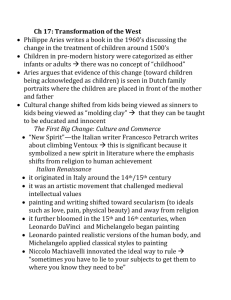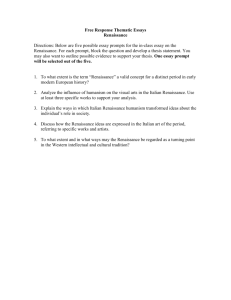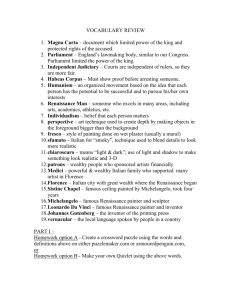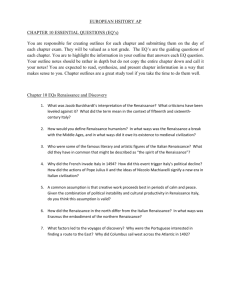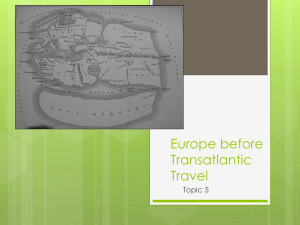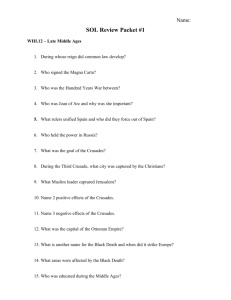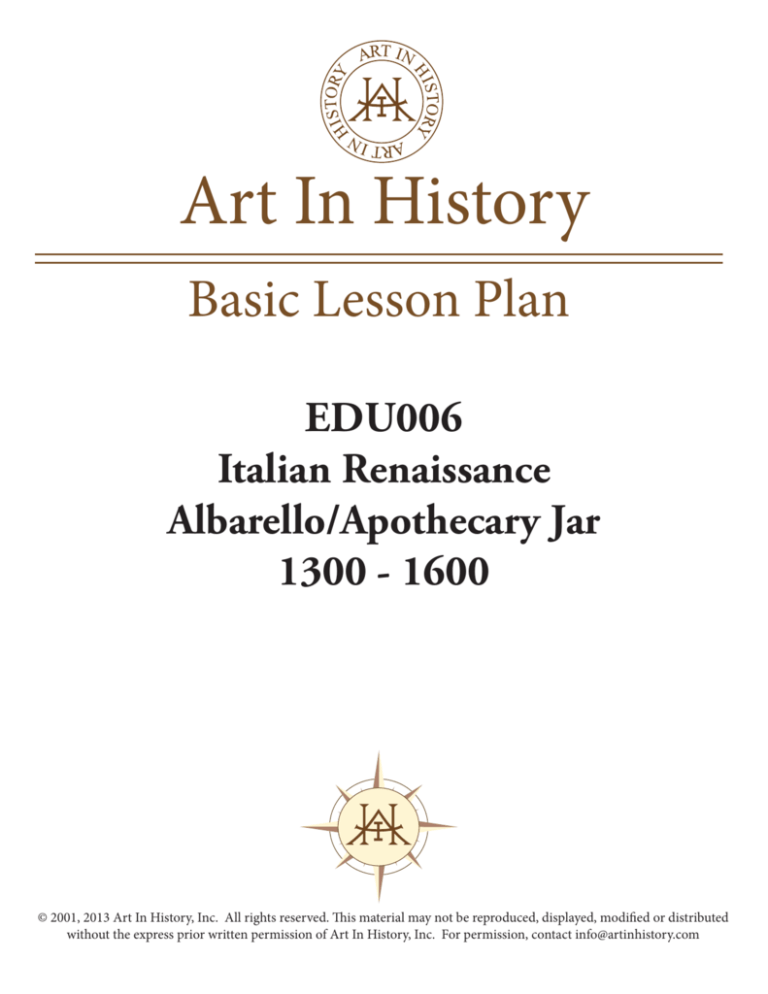
Art In History
Basic Lesson Plan
AIH
EDU006
Italian Renaissance
Albarello/Apothecary Jar
1300 - 1600
© 2001, 2013 Art In History, Inc. All rights reserved. This material may not be reproduced, displayed, modified or distributed
without the express prior written permission of Art In History, Inc. For permission, contact info@artinhistory.com
The Italian Renaissance: A Brief History
1300–1600
Geography
The Renaissance began in the Tuscany region of northern Italy. Centered in the city of
Florence the Renaissance slowly spread to the neighboring cities of Siena and Lucca. Eventually,
the ideas and developments of the Renaissance influenced the people throughout of the rest of
Europe.
The Renaissance in Italy
The Renaissance began in the 1300s in Europe. The term renaissance means rebirth. It
describes the intellectual and economic growth that took place throughout Europe from the
fourteenth through the sixteenth centuries. Specifically, it relates to a renewal of interest in the
arts and education, as well as a new importance placed on the individual.
The Middle Ages in Europe brought a difficult life to many. The Bubonic plague claimed
many lives. War was also an ongoing problem. As the many city-states of Italy emerged from the
Middle Ages, the citizens were looking for change. Writers began honoring life and looking at
the classical civilizations of Greece and Rome for inspiration.
Three main factors led to the Renaissance in Italy: successful cities; an economically
strong merchant class; and an interest in Classical Greek and Roman works.
The Role of the City-State
During the Crusades, many traders traveled through the various city-states of northern
Italy. Traders not only brought goods from far away lands, but also ideas and beliefs that were
new to Italy. Spices, dyes, and silks were transported through the city-states of northern Italy and
resold to markets in Europe. Likewise, languages and cultural influences moved back and forth
along the trade routes. Italians learned how to read the Classical Greek texts, and understand
Egyptian scientific and mathematical theories.
These factors led to the city-states becoming more urban than the rest of Europe, which
remained mostly rural. As the city-states grew in population, so did the exchange of ideas.
Unfortunately, the Bubonic plague struck Europe during the 1300s, devastating the population.
As many as 60% of the population was killed during the plague.
©Art In History, Inc., EDU006, V3, Italian Renaissance — Albarello/Apothecary Jar
The Italian city-states were very influential to all of Europe. The city-states of Italy
included Florence, Milan, Naples, Rome, and Venice. They provided an inspirational base for
many artists of various fields. Florence was a wealthy state and the site of many revolutionary
ideas about government, notably the democratic republic system. Milan was the center of
advanced education and artwork. Naples, located in Southern Italy, had a great maritime location
between the Mediterranean and Adriatic Seas. Rome was the home of many religious leaders,
including the Pope. Venice was a wealthy city-state built on the beautiful inland waterways of
the Adriatic Sea.
People of the Renaissance
The most influential family of the Italian Renaissance was the Medici family of Florence.
Cosimo Medici was head of the Medici family. Bankers by trade, the Medici family came into
power around 1434. For approximately 30 years, Cosimo ruled Florence as a form of dictator.
The power and influence of the Medici family helped to encourage the Enlightenment of the
Renaissance in Florence, which then spread throughout Europe. Cosimo Medici died in 1464.
By 1469, Cosimo’s grandson Lorenzo had taken over as the head of the family. Lorenzo
was a politician and patron of the arts, literature, and education. He was referred to as “Lorenzo
il Magnifico,” and his patronage helped to launch the careers of such famous artists as Donatello
and Michelangelo. Lorenzo also ruled Florence under a form of dictatorship.
Greek and Roman Influence
During the Renaissance, philosophies began to dramatically change while knowledge
grew and spread at incredible rates. Europe came out of the Middle Ages with economic
development and a renewed interest in the arts, sciences, and politics. Art was changing and
incorporating more creativity in every form, but at the same time, classical studies became
popular.
People of the Renaissance did not appreciate the art from the Middle Ages. Instead, they
were influenced by art and writing from the Classical Greek and Roman periods. Artwork and
literature began reflecting the styles of the ancient Roman culture, the ruins of which could be
found all around Italy. Writers began studying the manuscripts and writings that could be found
in monasteries. Some of these writing came from ancient Greece. By looking to the past for
©Art In History, Inc., EDU006, V3, Italian Renaissance — Albarello/Apothecary Jar
inspiration, the artists of the Renaissance changed the way people across the world viewed
themselves and their surroundings.
The Effects of the Renaissance
The result of the city-states combining with the influence of the Medici family and the
return to the classics led to changes in art, literature, architecture, science, and ultimately society.
As scholars studied the works of Classic Greece and Rome, they developed a belief known as
humanism. Humanism was a belief in the human potential and focused on achievements of
people. Humanist beliefs influenced art and sculpture as well as architecture. They also renewed
interest in the study of philosophy, literature, and history. Today, these topics are known as the
humanities—a term that is derived from humanism.
A second outcome of the Renaissance was a shift in religious thinking. This led to an
acceptance of a lifestyle that didn’t exist during the Middle Ages. During the Middle Ages, most
people lived lives that aligned to Christian teachings. They wore simple clothing, ate simple
food, and lived a life that strictly honored the Church. As scholars began exploring ancient
writings, a belief developed that allowed for people to enjoy the finer aspects of life without
offending the Church. Finer clothing, housing, music, and foods became popular, even among
Church officials.
As lifestyle changed, so did an appreciation of the arts. Church officials began building
beautiful cathedrals, such as St. Peter’s Basillica in Rome. The wealthy built mansions and began
commissioning artwork to fill their new homes. Many of these pieces of art were portraits of the
wealthy merchants and Church members. These patrons of the arts changed the style and
methods of painting and sculpture.
Eventually, the importance of learning shifted from scholars to the common person.
Writers such as Baldassare Castiglione’s (1478–1529) began influencing the common person.
The Book of the Courtier, published in 1528, explained the importance of being a well-rounded
person. Men, for example, should be able to ride a horse, play music, and write poetry. In time,
the people who did these things came to be known as Renaissance men. Similarly, women during
the Renaissance expanded their learning. They began reading the classics works of literature, and
became better educated than women of previous time periods.
The Arts
©Art In History, Inc., EDU006, V3, Italian Renaissance — Albarello/Apothecary Jar
The greatest legacy from the Renaissance can be seen in the arts. Considered one of the
greatest artists of the Renaissance era, Michelangelo Buonarroti’s (1475–1564) paintings,
sculptures, and other forms of art are still regarded as inspirational masterpieces. Michelangelo
was one of the very few who could incorporate traditional beauty, expressiveness, and raw
emotion into an art piece. A few of his astonishing achievements include the Sistine Chapel
ceiling, the statue of David, and his painting of The Last Judgment.
Leonardo da Vinci (1452–1519) is also one of the greatest Renaissance artists, although
he also developed advanced scientific theories, sculpture, and many inventions. Da Vinci’s most
famous painting is the Mona Lisa. He also painted The Last Supper, which depicts the disciples
of Jesus. Many of da Vinci’s writings still exist, however they are difficult to read—he wrote
backwards! No one knows why he did this, but holding his writing up to a mirror is the best way
to read his script.
The Renaissance not only promoted art, but also humanistic ideals such as individuality,
as well as a renewal of science, literature, philosophy, and architecture. Francesco Petrarch
(1304–1374) is one of the best known writers from the Renaissance. He was a humanist, and is
often referred to as the father of humanism. Writing in both Latin and Italian, his poetry is about
a woman named Laura who was his ideal woman.
Niccolo Machiavelli’s (1469–1527) The Prince is also a well known writing of the time.
The book examines how a ruler should act in order to keep power. It was controversial because
Machiavelli focused on what a ruler had to do, rather than what was morally correct. He includes
ways to trick enemies and manipulate his subjects.
The End of the Renaissance
Due to Italy’s geographical location, prosperity, people, and lack of unification, the
Italian city-states were targets of invasions. The French, Germans, Spanish, Swiss, and many
other nations had interest in the Northern Italian region. At the height of the Italian Renaissance
in the 1400s, Europe began to fight for dominance over the Italian peninsula. Beginning in 1494,
the kings of France ordered a series of military campaigns into Italy known as the Italian Wars.
They attempted to conquer the states of Naples and Milan. France captured Milan, but then
partly withdrew from Naples.
©Art In History, Inc., EDU006, V3, Italian Renaissance — Albarello/Apothecary Jar
In 1500, King Louis XII of France and King Ferdinand of Spain agreed to divide Naples
into two sections. All attempts of peace were futile and, two years later, France and Spain went
to war over the kingdom of Naples. Spain gained total control of Naples by 1505. From the years
1510 to 1514, the French were slowly but completely driven out of Italy by the Holy League,
(Papacy, Spain, Venice, and Swiss Confederation). However, one year later, the French began a
counterattack against the Swiss. By 1516, France had regained control of Milan and much of
Northern Italy, but gave up its claim to Naples. A period of relative peace followed.
Adding to the decline of the Renaissance was the migration of many great artists out of
Italy. For example, Leonardo da Vinci left Italy in 1516 and moved to France. The discovery of a
water route to the far east by Vasco de Gama, in 1498, also contributed to a slowing down of
trade going through the Italian city-states. Trade goods now traveled by water through ports such
as Lisbon and London. Although the Renaissance continued through the 1500s, most historians
agree that by 1600 it had come to an end. The Renaissance and the many different cultural
influences it brought about provided the world with a uniquely humanistic style that can still be
appreciated through artwork, architecture, fashion, music, painting, and sculpture.
©Art In History, Inc., EDU006, V3, Italian Renaissance — Albarello/Apothecary Jar
MAP 2: Italy, circa 1450
©Art In History, Inc., EDU006, V3, Italian Renaissance — Albarello/Apothecary Jar
The Albarello/Apothecary /Apothecary Jar: A Brief History
1478–1550
Art in History’s replica is an example of an Italian Apothecary Jar from the Renaissance period.
During this time, people were making new discoveries in art, science, and medicine. Special ceramic jars
were needed to hold the medicines and spices. Islamic potters created non-porous earthenware with tin glaze
that was suitable for storing medicines. This earthenware had many uses and was traded throughout Spain
and Italy. It became known as maiolica.
A maiolica jar used for storing medicine is called an albarello. The first apothecary jars were made in
the Middle East. During the Renaissance, Islamic art styles and new commerce in medicine began to
AIH
influence Italy. New centers for glazed earthenware were established, and Italy became very well-known for
its manufacturing of maiolica.
An albarello has a cylindrical shape with concave sides that curve inward toward the middle of the
jar. They are made with a tin oxide and lead glaze. This application gives the body a dense, white cover.
Decorations can then be painted without running or blurring. Albarello jars are painted with blue (cobalt),
green (copper), purple and brown (manganese), yellow (antimony), and orange (antimony and iron). Firing at
a low temperature fuses the glaze and sets the color. Motifs include vibrant outlines, foliage patterns, scrolled
leaf patterns, animals, busts, and scrolling ribbons. Concentric bands of ornament were common, but later a
style based on pictures evolved.
The earliest apothecary jars had no labels, so they could be used and reused for a variety of
medicines. Sometimes labels would be attached to the vessel to indicate its contents. The practice of firing
the name of the contents into the decoration of Italian apothecary jars started around 1500. Labeled jars are
also seen in a painting at a castle in Northern Italy (circa 1490–1509).
The manufacturing of apothecary jars and other maiolica spread throughout Europe. Today, maiolica
like this can be found in the Taft Museum, the Metropolitan Museum of Art, and other galleries around the
world. More information about apothecary jars and maiolica from this time period can be found in libraries
and online.
©Art In History, Inc., EDU006, V3, Italian Renaissance — Albarello/Apothecary Jar
SAMPLE MOTIFS
AIH
Finished Examples
Finished Examples
©Art In History, Inc., EDU006, V3, Italian Renaissance — Albarello/Apothecary Jar
AIH
Finished Examples
A, B
A, B
Top Border Motifs
©Art In History, Inc., EDU006, V3, Italian Renaissance — Albarello/Apothecary Jar
A, B
A, C
AIH
Middle Motifs
A, C
A, B
Middle Motifs
©Art In History, Inc., EDU006, V3, Italian Renaissance — Albarello/Apothecary Jar
AIH
A, B
A, B
Middle Motifs
A, C
A, B
Middle Motifs
©Art In History, Inc., EDU006, V3, Italian Renaissance — Albarello/Apothecary Jar
Design and Motif Codes
A. The earliest apothecary jars had no labels, so they could be used and reused for a variety of medicines.
Sometimes labels would be attached to the vessel to indicate its contents. The practice of firing the name of
the contents into the decoration of Italian apothecary jars started around 1500.
B. The top of apothecary jars were decorated with ornate and colorful borders. Some Italian motifs include
vibrant outlines, foliage patterns, scrolled leaf patterns, animals, busts, and scrolling ribbons. Concentric
bands of ornament were common, but later a style based on pictures evolved.
C. Beyond the ornate and colorful decorations, the surfaces of maiolica objects were painted with portraits,
coats-of-arms and narrative scenes from mythology, history, and religion.
AIH
©Art In History, Inc., EDU006, V3, Italian Renaissance — Albarello/Apothecary Jar
STEP-BY-STEP PAINTING DIRECTIONS
(students can work in small groups)
I. APPLY THE BASE COLOR
1. Shake the colored stains. Pour a small amount of WHITE stain onto the plate palette. Using the
sponge, apply one coat of WHITE stain on the outside of the jar, so the replica is uniform in color.
Allow a few minutes to dry.
2. When the jar is dry, students may write their name on the bottom.
II. PENCIL SKETCH DESIGNS ON JAR
1. Using a pencil and paper, students should draw their designs. Next, they may begin drawing their
designs onto the replica. NOTE: Remind students before they begin drawing to SKETCH LIGHTLY on
their pottery. Pencil lines are easily erased as long as they are drawn lightly. It is important to
understand that the pencil lines will be a map, or guide, for applying the stains. Designs should be
checked for accuracy before any painting begins.
AIH
2. To draw horizontal lines at the top and bottom of the jar, students should place the tip of their pencil
where they want the line to appear. While holding the jar in their other hand, slowly rotate the jar, and
press down lightly with the pencil. NOTE: A rubber band may also be used as a guide.
3. Next, divide the middle section of the jar into four equal parts. The lines should go from the top line to
the bottom line (created in the previous step). The jar should have four equal square decorating areas
that will be filled with the motifs.
4. Draw the detailed designs from their sketches into the middle sections of the jar.
III. PAINT ON THE JAR
Remember: Use cups of water to clean paintbrushes when changing paint colors.
After students are finished sketching designs on their vessels, they are ready to paint. Pour a small
amount of BLUE and CHROME ORANGE stain onto the palette. NOTE: To create a thin paint line
dip brush in water first then in paint. This will result in a fluid flow of paint.
1. Use the paintbrush and the BLUE and CHROME ORANGE stains for painting the motifs. NOTE:
before applying paint to the replica, test the amount of paint on your brush by dabbing it on a piece of
paper.
2. Add areas of “wash” in various places of the decoration. A “wash” is a term for paint that has been
thinned with water, giving it a “watercolor” effect when used. NOTE: fix any mistakes and remove
excess water with paper towels.
3. Suggest to your students that they experiment with different ways of holding the replica as they paint.
Encourage them to turn the jar upside down, put their hands inside it, brace it against the table, or
whatever is comfortable for them.
©Art In History, Inc., EDU006, V3, Italian Renaissance — Albarello/Apothecary Jar

